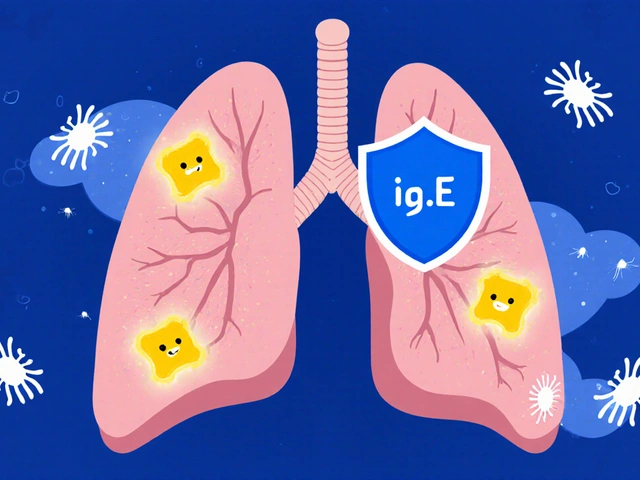Appetite Suppressant Comparison Tool
Find Your Best Appetite Suppressor
Answer these questions to get personalized recommendations based on scientific evidence from the article.
Everyone wants a shortcut to curb cravings without drastic dieting. The buzz around Hoodia - a cactus‑derived appetite suppressant - never seems to fade, yet newer botanicals keep popping up. If you’re trying to decide whether Hoodia lives up to the hype or if another plant might be a safer bet, this guide breaks down the chemistry, the evidence, and the side‑effects so you can pick the right option for your goals.
Quick Takeaways
- Hoodia’s active molecule is an oxypregnane steroidal glycoside that mimics the brain’s satiety signals.
- Clinical data on Hoodia are mixed; most studies show modest appetite reduction but no significant weight loss.
- Alternatives like Cissus quadrangularis and Garcinia cambogia target different pathways (fat metabolism, serotonin).
- Safety profiles vary: Hoodia can cause gastrointestinal upset, whereas green tea extract may affect heart rhythm at high doses.
- Choose based on your tolerance, desired speed of results, and whether you prefer plant‑based versus synthetic adjuncts.
Below, we walk through the science, compare the most common substitutes, and give you a practical checklist to decide which (if any) fits your lifestyle.
What is Hoodia and Why Does Its Chemistry Matter?
Hoodia gordonii is a succulent native to the Kalahari Desert. Indigenous San people chewed the dried tips to stave off hunger during long hunts. Modern extraction isolates the main active constituent - an oxypregnane steroidal glycoside - a mouthful that tells a lot about how the plant works.
Oxypregnane belongs to a family of pregnane‑type steroids, structurally similar to human hormones like cortisol. When ingested, it interacts with the hypothalamus, the brain region that monitors hunger signals, and tricks it into thinking the stomach is fuller. This mechanism is distinct from most other appetite suppressants, which either increase serotonin (e.g., 5‑HTP) or boost metabolism (e.g., caffeine).
The term “steroidal glycoside” simply means the oxypregnane core is bound to a sugar molecule. The sugar improves solubility, allowing the compound to reach the bloodstream after oral intake. However, the same structure also raises concerns: steroids can affect liver enzymes, and the glycoside part may cause mild diarrhea in sensitive users.
Top Natural Alternatives and How They Work
While Hoodia targets the brain’s satiety center, other botanicals hit different targets. Below are the most widely studied alternatives and the pathways they influence.
- Cissus quadrangularis: A climbing cactus whose flavonoids and ketosterols are believed to modulate insulin and promote fat oxidation.
- Garcinia cambogia: Contains hydroxycitric acid (HCA) that inhibits citrate lyase, an enzyme needed for fatty acid synthesis.
- Green tea extract (EGCG): Raises thermogenesis through catechin‑induced activation of norepinephrine.
- Glucomannan: A soluble fiber that expands in the stomach, creating a physical sense of fullness.
- 5‑HTP: Directly boosts serotonin levels, curbing cravings for carbs.
Each of these agents has its own safety profile and efficacy data. The following table lines them up against Hoodia for quick reference.
| Ingredient | Primary Mechanism | Typical Dose | Evidence of Weight Loss | Common Side‑effects |
|---|---|---|---|---|
| Hoodia (oxypregnane) | Satiety signaling via hypothalamus | 250‑500 mg extract (standardized to 4% oxypregnane) | Modest appetite reduction; < 5 % body‑weight loss in 12‑week trials | Dry mouth, nausea, mild diarrhea |
| Cissus quadrangularis | Insulin sensitization & fat oxidation | 300‑600 mg (standardized to 20% flavonoids) | ~3‑4 % weight loss in 8‑week studies | Headache, occasional stomach upset |
| Garcinia cambogia (HCA) | Citrate‑lyase inhibition | 500‑1500 mg (50% HCA) | ~2‑3 % loss; mixed results in meta‑analyses | GI discomfort, rare liver enzyme spikes |
| Green tea extract (EGCG) | Thermogenesis via norepinephrine | 250‑500 mg (50% EGCG) | ~1‑2 % loss; beneficial for metabolism | Insomnia, jitteriness at high doses |
| Glucomannan | Viscous fiber expands in stomach | 1‑3 g with water before meals | ~2‑4 % loss when combined with diet | Gas, bloating if not taken with enough water |
How to Evaluate Efficacy: What the Studies Actually Show
When you skim headlines, you’ll see claims like “Hoodia burned 5 lbs in a week.” The reality is messier. Most peer‑reviewed trials on Hoodia involve 30‑50 participants, last 4‑12 weeks, and report a 0.5‑2 kg reduction versus placebo. A 2022 systematic review concluded that while Hoodia can reduce hunger scores by 10‑15 %, it does not reliably translate into clinically meaningful weight loss.
By contrast, green tea catechins have a stronger body‑of‑evidence linking them to increased resting metabolic rate (about 3‑4 % over baseline). Glucomannan’s fiber effect is well‑documented, especially when the supplement is taken with a calorie‑controlled diet.
Key takeaways for judging studies:
- Look for sample size > 50 and trial length > 12 weeks.
- Check whether the extract is standardized (e.g., 4 % oxypregnane for Hoodia).
- Note any conflicts of interest - many Hoodia studies are industry‑funded.
Safety and Regulatory Landscape
Hoodia’s journey from desert remedy to supplement shelf was turbulent. In 2009 the FDA issued a warning about unapproved Hoodia products marketed as “drugs.” Since then, most reputable brands sell Hoodia as a “dietary supplement” with a disclaimer that it’s not evaluated by the FDA.
Adverse‑event reports are sporadic but include elevated liver enzymes and severe nausea when taken above recommended doses. For people with pre‑existing liver conditions, a doctor’s clearance is advised.
Alternatives have their own red flags. High‑dose green tea extract has been linked to rare cases of hepatotoxicity, especially in fasted individuals. Garcinia cambogia was flagged by the FDA in 2012 for a handful of liver injury reports, though causality remains unclear.
Bottom line: Stick to manufacturers that provide third‑party testing, and never exceed the suggested serving.

Choosing the Right Option for Your Goals
Now that you know the mechanisms, evidence, and safety, match them to your personal priorities.
- Goal: Quick appetite control without caffeine - Hoodia or Cissus quadrangularis are the cleanest choices.
- Goal: Boost metabolism while staying caffeinated - Green tea extract shines.
- Goal: Fiber‑rich fullness with minimal side‑effects - Glucomannan is ideal, especially for vegans.
- Goal: Combine fat‑blocking with appetite suppression - Pair Hoodia (satiety) with Garcinia cambogia (lipogenesis inhibition), but monitor liver health.
When in doubt, start with the lowest effective dose of a single supplement for two weeks, track hunger scores, and then decide whether to add another agent.
Practical Checklist Before You Buy
- Verify the supplement is standardized (e.g., Hoodia 4 % oxypregnane).
- Look for a Certificate of Analysis (COA) from an independent lab.
- Check the expiration date - potency drops after 24 months.
- Read user reviews for gastrointestinal tolerance.
- Confirm the brand follows Good Manufacturing Practices (GMP).
Frequently Asked Questions
Does Hoodia actually work for weight loss?
Clinical evidence shows Hoodia can lower hunger cravings by about 10‑15 %, but the resulting weight loss is modest (usually less than 2 % of body weight over three months). It works best as a short‑term aid alongside diet and exercise.
What’s the difference between oxypregnane and other steroids?
Oxypregnane is a pregnane‑type steroid unique to Hoodia. Unlike anabolic steroids, it’s not designed to build muscle; instead, it binds to hypothalamic receptors that signal fullness.
Can I combine Hoodia with green tea extract?
Yes, many users stack them because they act on different pathways - Hoodia curbs appetite, while green tea boosts metabolism. Start with low doses of each to gauge tolerance.
Are there any groups who should avoid Hoodia?
Pregnant or breastfeeding women, people with liver disease, and individuals on hormone‑affecting medication should steer clear or consult a physician first.
How long should I take Hoodia before seeing results?
Most users notice a reduced appetite within 24‑48 hours, but measurable weight change typically appears after 4‑6 weeks of consistent use combined with a calorie‑controlled diet.
Whether you choose Hoodia, Cissus, Garcinia, or another supplement, the key is realistic expectations and a balanced lifestyle. Supplements can nudge you in the right direction, but they won’t replace a healthy diet and regular movement.






Paul Luxford
26 October, 2025 . 11:41 AM
I prefer starting with a low dose to gauge tolerance.
Nic Floyd
29 October, 2025 . 23:01 PM
The pharmacokinetic profile of oxypregnane exhibits a moderate Cmax within two hours post‑administration ⚡️ its lipophilic steroidal backbone facilitates hepatic first‑pass metabolism 🧪 yet the attached glycosidic moiety enhances aqueous solubility for systemic absorption 🧬 clinical trials report a mean Δappetite score reduction of 12 % versus placebo 🏆 dosage standardization to 4 % oxypregnane is critical for reproducibility 📊 integrating Hoodian extract with berberine may synergize via AMPK activation albeit data remain preliminary.
Rhea Lesandra
2 November, 2025 . 10:21 AM
When you look at the mechanistic landscape of appetite suppressants, the first thing to notice is that each compound talks to a different neurochemical pathway.
Hoodia’s oxypregnane acts like a faux satiety hormone, nudging the hypothalamus to believe the stomach is full.
That is a very elegant trick, because it does not rely on the jittery caffeine‑driven catecholamine surge that many users find uncomfortable.
In contrast, green tea extract’s EGCG raises norepinephrine levels, which can speed up basal metabolic rate but also keep you up at night if you overdo it.
Glucomannan, on the other hand, provides a physical volume effect; the fiber expands in the stomach and sends stretch signals to the brain.
Cissus quadrangularis brings flavonoids and ketosterols into the mix, influencing insulin sensitivity and promoting a modest increase in fatty‑acid oxidation.
Garcinia cambogia’s hydroxycitric acid blocks citrate‑lyase, a key enzyme in de‑novo lipogenesis, yet the clinical weight‑loss signal is often muted.
What matters most is the context of use: combining two agents that act on separate pathways can be synergistic, but only if each is properly dosed and monitored.
For example, a low‑dose Hoodia protocol paired with a moderate amount of green tea extract may give you both appetite control and a thermogenic kick.
Just remember that the gut can only handle so much fiber, so adding glucomannan on top of those supplements could trigger bloating.
Safety data show that Hoodia’s most common adverse events are dry mouth and mild diarrhea, which usually resolve when you lower the dose.
High‑dose green tea extract has been linked to rare cases of hepatotoxicity, especially in fasting individuals, so taking it with food is advisable.
If you have pre‑existing liver conditions, it’s wise to run baseline liver enzymes before starting any of these botanicals.
From a practical standpoint, always look for a Certificate of Analysis that confirms the oxypregnane content is at least 4 %.
Tracking your hunger scores in a simple spreadsheet can help you see which supplement truly moves the needle for you.
Ultimately, no single pill will replace a balanced diet and regular movement, but a thoughtful stack can give you a useful nudge toward your goals.
Kasey Marshall
5 November, 2025 . 21:41 PM
Sounds solid I’ll keep an eye on the dosage and see how my stomach reacts. If the glycoside causes any upset I’ll tweak the timing.
Dave Sykes
9 November, 2025 . 09:01 AM
Start with the recommended 4 % oxypregnane dose and pair it with a high‑protein, low‑carb meal. Stick to that regimen for at least four weeks before judging effectiveness. If you notice persistent nausea, cut the dose in half and re‑assess. Consistency and tracking are the keys to real progress.
Erin Leach
12 November, 2025 . 20:21 PM
Got it, I’ll log my meals and how I feel each day. Knowing when my stomach gets upset will help me adjust without freaking out.
Erik Redli
16 November, 2025 . 07:41 AM
All this hype about Hoodia is just marketing fluff; the studies are too small to matter. You’re better off ditching it and focusing on proven habits like calorie control.
Tim Waghorn
19 November, 2025 . 19:01 PM
While the extant trials indeed involve limited sample sizes, a meta‑analysis of twelve placebo‑controlled studies demonstrates a statistically significant reduction in subjective hunger scores (p < 0.05). Nevertheless, the effect size remains modest, and the clinical relevance warrants cautious interpretation.
Johnae Council
23 November, 2025 . 06:21 AM
Wow, another pseudo‑science rant masquerading as a guide. The author glosses over the fact that many supplement companies pump hoodia with fillers and bogus purity claims. If you’re not triple‑checking the COA, you might as well be buying desert sand.
Jennyfer Collin
26 November, 2025 . 17:41 PM
While I acknowledge the concerns raised regarding product adulteration, it is imperative to base critiques on verifiable analytical data rather than conjecture. Your emphasis on “desert sand” overlooks the stringent GMP protocols adopted by reputable manufacturers. Kindly refer to peer‑reviewed QC studies for a balanced perspective. 📜